Advertisements
Advertisements
प्रश्न
Answer the following question.
What are the advantages of optical fibre communication over electronic communication?
उत्तर
Advantages:
- Broad bandwidth (frequency range): For TV signals, a single optical fibre can carry over 90000 independent signals (channels).
- Immune to EM interference: Optical fibre being electrically non-conductive, does not pick up nearby EM signals.
- Low attenuation loss: loss being lower than 0.2 dB/km, a single long cable can be used for several kilometres.
- Electrical insulator: Optical fibres being electrical insulators, ground loops of metal wires or lightning do not cause any harm.
- Theft prevention: Optical fibres do not use copper or other expensive material which are prone to be robbed.
- Security of information: Internal damage is most unlikely to occur, keeping the information secure.
APPEARS IN
संबंधित प्रश्न
A ray of light travels from water to air as shown in the diagram given below :

1) Copy the diagram and complete the path of the way. Given the critical angle for water is 48°.
2) State the condition so that internal reflection occurs in the above diagram.
The figure shows a ray of light falling normally on the face AB of an equilateral glass prism having refractive index`3/2`, placed in water of refractive index `4/3`.Will this ray suffer total internal reflection on striking the face AC? Justify your answer.
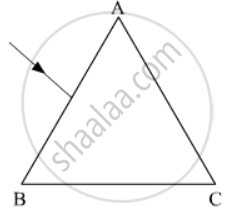
Draw the diagram of a right-angled isosceles prism which is used to make an invented image erect
What do you understand by the deviation produced by a prism? Why is it caused?
Draw diagram to illustrate the total internal reflection.
Two isosceles right-angle glass prisms P and Q are placed near each other as shown in Fig. Complete the path of the light ray entering the prism P till it emerges out of the prism Q.
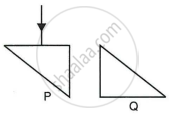
Write the necessary conditions for the phenomenon of total internal reflection to
occur ?
i) Observe the given figure and answer the following questions.
a) Identify and write the natural process shown in the figure.
b) List the phenomena which are observe in this process.
c) Redraw the diagram and show above phenomena in it.
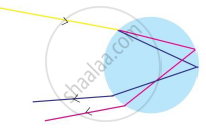
If a light ray does not undergo, refraction at the boundary between two media, the angle of incidence is:
Write down the relationship between the critical angle and the refractive index of the medium.
If a ray of light passes from medium I to medium II without any change of direction, what can be said about the refractive indices of these media (angle I is not 0)?
How are critical angles related to the refractive index of the medium?
State two advantages of using a right-angle prism as a reflector, rather than a plane mirror.
Complete the following diagram to show the path of the ray of a single colour in the diagram as if enters in and emerges out of the prism. Mark the angles wherever necessary. (Critical angle for glass = 42°).
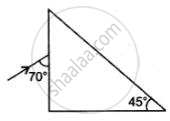
PQ and PR are two light rays emerging from the object as shown in the figure below:
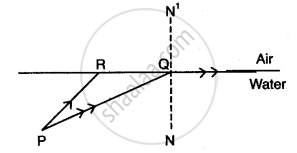
(i) What is the special name given to the angle of incidence (∠PQN) of ray PQ?
(ii) Copy the ray diagram and complete it to show the position of the image of the object P when seen obliquely from above.
(iii) Name the phenomenon that occurs if the angle of incidence ∠PQN is increased still further.
Answer the following question.
Explain ‘mirage’ as an illustration of refraction.
Answer the following question.
Define the critical angle of incidence and obtain an expression for it.
Which one of the following is NOT the correct formula for refractive index of glass w.r.t. air (aμg) (i = angle of incidence, r = angle of refraction)
For a ray of light, the critical angle is minimum when it travels from ______.
Total internal reflection can take place only if light is travelling from ______.
The outer concentric shell in optic fiber is called ______.
A bundle of glass threads, each of which is capable of transmitting messages using light waves is called ______.
Which of the following statements about total internal reflection is true?
Define the critical angle.
What are the examples of total internal reflection in nature?
The phenomena involved in the reflection of radiowaves by ionosphere is similar to ______.
A rectangular block of glass ABCD has a refractive index 1.6. A pin is placed midway on the face AB (Figure). When observed from the face AD, the pin shall ______.
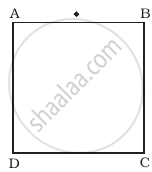
- appear to be near A.
- appear to be near D.
- appear to be at the centre of AD.
- not be seen at all.
A ray of light passes from vacuum into a medium of refractive index µ, the angle of incidence is found to be twice the angle of refraction. Then the angle of incidence is ______.
